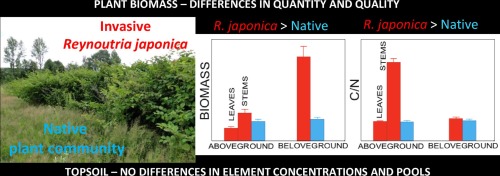Our official English website, www.x-mol.net, welcomes your feedback! (Note: you will need to create a separate account there.)
Large differences in biomass quantity and quality between invasive Reynoutria japonica and resident vegetation are not reflected in topsoil physicochemical properties
Geoderma ( IF 6.1 ) Pub Date : 2020-06-01 , DOI: 10.1016/j.geoderma.2020.114307 Anna M. Stefanowicz , Angelika Banaś , Małgorzata Stanek , Marcin W. Woch , Szymon Zubek
Geoderma ( IF 6.1 ) Pub Date : 2020-06-01 , DOI: 10.1016/j.geoderma.2020.114307 Anna M. Stefanowicz , Angelika Banaś , Małgorzata Stanek , Marcin W. Woch , Szymon Zubek

|
Abstract Biological invasions are an important element of ongoing global change. Reynoutria japonica is one of the most invasive plant species in Europe and North America, potentially affecting recipient ecosystems. However, little is known about the relationships between its senescing biomass and element concentrations/pools in soil. The aim of this study was to compare the quantity and quality of aboveground and belowground plant biomass, and the quality of topsoil between plots with invasive R. japonica and resident plant communities. The study was conducted at 25 paired R. japonica-native plots in southern Poland. Harvested biomass was dried and weighted, and characterized in terms of C, Ca, K, Mg, N and P concentrations and pools, as well as C/N and C/P ratios. These parameters were also measured in soil along with texture, bulk soil density, moisture and pH. R. japonica produced greater amounts of aboveground and belowground biomass relative to resident species. The concentrations and pools of most elements in plant biomass were affected by invasion (R. japonica vs. resident), biomass type (aboveground vs. belowground) and/or their interactions. Senescing aboveground biomass of R. japonica was characterized by poor quality – lower N, P, K, greater C, Ca concentrations and greater C/N, C/P ratios compared to resident vegetation. Belowground R. japonica biomass had either greater or similar element concentrations (with the exception of P) or ratios. Element pools were greater in R. japonica than in resident species, with the exception of N and P in aboveground biomass. Despite these differences, topsoil generally did not differ in physicochemical properties when analyzed across all study sites; only total N and H2O-extractable K pools were lower under R. japonica than resident vegetation. Our data suggest that ecosystem response to invasion may be site-specific and depend on initial ecosystem properties.
中文翻译:

侵入性粳稻与常驻植被在生物量数量和质量上的巨大差异并未反映在表土理化性质上
摘要 生物入侵是全球持续变化的一个重要因素。Reynoutria japonica 是欧洲和北美最具入侵性的植物物种之一,可能影响受体生态系统。然而,人们对其衰老的生物量与土壤中元素浓度/池之间的关系知之甚少。本研究的目的是比较地上和地下植物生物量的数量和质量,以及具有入侵性粳稻和常驻植物群落的地块之间的表土质量。该研究是在波兰南部的 25 个配对的粳稻原生地块中进行的。收获的生物质经过干燥和称重,并根据 C、Ca、K、Mg、N 和 P 浓度和池以及 C/N 和 C/P 比率进行表征。还在土壤中测量了这些参数以及质地、土壤体积密度、水分和pH值。与常驻物种相比,粳稻产生更多的地上和地下生物量。植物生物量中大多数元素的浓度和库受入侵(R. japonica vs. resident)、生物量类型(地上 vs. 地下)和/或其相互作用的影响。与常驻植被相比,R. japonica 衰老的地上生物量的特点是质量差——较低的 N、P、K、较高的 C、Ca 浓度和较高的 C/N、C/P 比率。地下 R. japonica 生物量具有更高或相似的元素浓度(P 除外)或比率。除了地上生物量中的 N 和 P 之外,R. japonica 的元素库比常驻物种更大。尽管存在这些差异,在所有研究地点进行分析时,表土的物理化学性质通常没有差异;只有总 N 和 H2O 可提取的 K 池在 R. japonica 下低于常驻植被。我们的数据表明,生态系统对入侵的反应可能是特定于地点的,并取决于初始生态系统特性。
更新日期:2020-06-01
中文翻译:

侵入性粳稻与常驻植被在生物量数量和质量上的巨大差异并未反映在表土理化性质上
摘要 生物入侵是全球持续变化的一个重要因素。Reynoutria japonica 是欧洲和北美最具入侵性的植物物种之一,可能影响受体生态系统。然而,人们对其衰老的生物量与土壤中元素浓度/池之间的关系知之甚少。本研究的目的是比较地上和地下植物生物量的数量和质量,以及具有入侵性粳稻和常驻植物群落的地块之间的表土质量。该研究是在波兰南部的 25 个配对的粳稻原生地块中进行的。收获的生物质经过干燥和称重,并根据 C、Ca、K、Mg、N 和 P 浓度和池以及 C/N 和 C/P 比率进行表征。还在土壤中测量了这些参数以及质地、土壤体积密度、水分和pH值。与常驻物种相比,粳稻产生更多的地上和地下生物量。植物生物量中大多数元素的浓度和库受入侵(R. japonica vs. resident)、生物量类型(地上 vs. 地下)和/或其相互作用的影响。与常驻植被相比,R. japonica 衰老的地上生物量的特点是质量差——较低的 N、P、K、较高的 C、Ca 浓度和较高的 C/N、C/P 比率。地下 R. japonica 生物量具有更高或相似的元素浓度(P 除外)或比率。除了地上生物量中的 N 和 P 之外,R. japonica 的元素库比常驻物种更大。尽管存在这些差异,在所有研究地点进行分析时,表土的物理化学性质通常没有差异;只有总 N 和 H2O 可提取的 K 池在 R. japonica 下低于常驻植被。我们的数据表明,生态系统对入侵的反应可能是特定于地点的,并取决于初始生态系统特性。



























 京公网安备 11010802027423号
京公网安备 11010802027423号